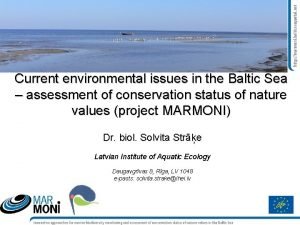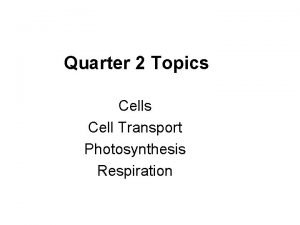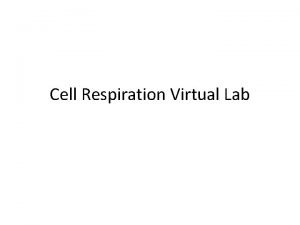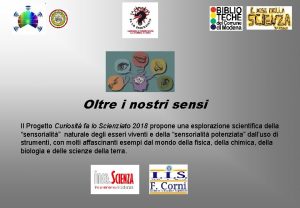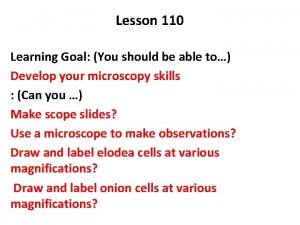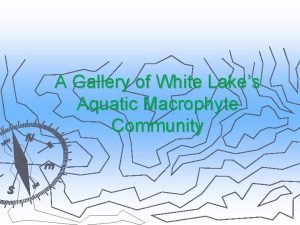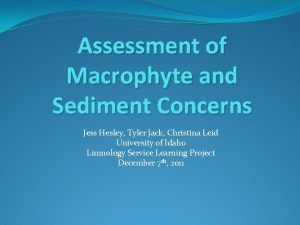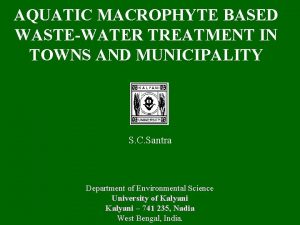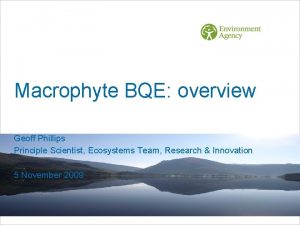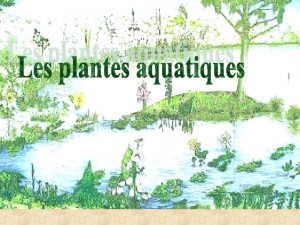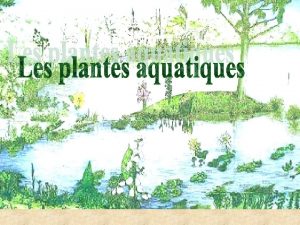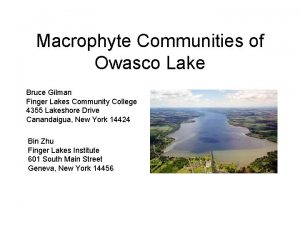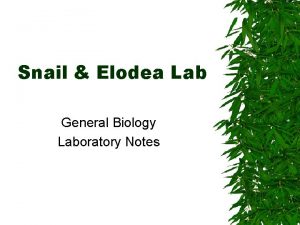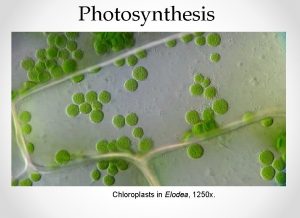Figure 12 1 The macrophyte Elodea with O














- Slides: 14

Figure 12. 1 The macrophyte Elodea with O 2 bubbles from photosynthesis. Freshwater Ecology: Concepts and Environmental Applications of Limnology © 2019

Figure 12. 2 Chemical associations with dissolved, colloidal, and gravitoidal particles. The association is depicted with three trace substances, inorganic copper and magnesium ions and the three-ringed organic compound phenanthrene. Dissolved chemicals depicted include a variety of organic chemicals. Colloidal particles include membrane pieces, viruses, inorganic precipitates, and aggregations of organic chemicals. Gravitoidal particles include clays, planktonic cells, and larger aggregates of organic and inorganic materials. Redrawn from Gustafsson and Gschwend (1997). Freshwater Ecology: Concepts and Environmental Applications of Limnology © 2019

Figure 12. 3 Cumulative curves showing the frequency distribution of various ions in water running off land. Each line shows the percentage of water samples with less than the corresponding concentration. Redrawn from Davis and De Wiest (1966). Freshwater Ecology: Concepts and Environmental Applications of Limnology © 2019

Figure 12. 4 Representative Gibbs free energy diagrams for ammonium and nitrate ions in oxidizing and reducing environments. The activation energy is the energy required to move from a state of high to low potential energy, and the energy yield is what is released when the transformation occurs. The activation energy plus the energy yield are required to accomplish a transformation from low to high potential energy. Freshwater Ecology: Concepts and Environmental Applications of Limnology © 2019

Figure 12. 5 Microbe-mediated chemical transformations plotted to show energy yield as the difference between the tail and the head of the arrow and redox potential required to complete transformation. Redrawn from Stumm and Morgan (1981). Freshwater Ecology: Concepts and Environmental Applications of Limnology © 2019

Figure 12. 6 Temporal patterns of temperature, O 2, redox, and total iron in Esthwaite Water (an English lake) over a year. This type of figure is common for representing time series in lakes. The contours represent the boundaries of the values, with depth on the y-axis and time on the x-axis. Redrawn from Mortimer (1941). Freshwater Ecology: Concepts and Environmental Applications of Limnology © 2019

Figure 12. 7 Saturation concentrations of dissolved O 2 as a function of temperature and altitude. The equation that describes the curve is: ln(O 2)52. 6921. 2731024 (alt)6. 15310210 (alt)20. 0286 (temp)12. 7231024 (temp)22. 0931026 (temp)3, where O 25 mg/L, alt is altitude in meters, and temp is temperature in o. C. Equations modified from Eaton et al. (1995). Freshwater Ecology: Concepts and Environmental Applications of Limnology © 2019

Figure 12. 8 Diagram of a representative relationship between net photosynthetic rate and irradiance (A) and comparison of high-light- and low-light-adapted species (B). The low-light species has a steeper α, lower compensation point and Pmax, and greater photoinhibition. Irradiance is in photosynthetically available radiation, and photosynthetic rate is in arbitrary units. A single species can acclimate to light in a similar fashion. Freshwater Ecology: Concepts and Environmental Applications of Limnology © 2019

Figure 12. 9 The relationship between photosynthetic rate and temperature based on 94 measurements of stream epilithon production in 14 studies. Reproduced with permission from De. Nicola (1996). Freshwater Ecology: Concepts and Environmental Applications of Limnology © 2019

Figure 12. 10 The relationship between water velocity and photosynthetic rate of the benthic cyanobacterium Nostoc. From Dodds (1989), with permission of the Journal of Phycology. Freshwater Ecology: Concepts and Environmental Applications of Limnology © 2019

Figure 12. 11 O 2 profiles from the stratified Triangle Lake, Oregon, on October 1, 1983, mid-morning (A) and from the South Saskatchewan River in an active algal mat, midday on June 9, 1993 (B). Note the lack of O 2 in the hypolimnion and the possible deep photosynthetic activity (at 1014 m) that causes a slight increase in O 2 in (A) and the supersaturating O 2 concentration at the sediment surface (B). Data for (A) courtesy of R. W. Castenholz; data for (B) from Bott et al. (1997). Freshwater Ecology: Concepts and Environmental Applications of Limnology © 2019

Figure 12. 12 Temporal variation in O 2 in Kansas groundwater (A), the pelagic and littoral zones of an Indiana lake (B), a periphyton assemblage (C), and a stream (D). Data in (A) courtesy of Konza Prairie long-term ecological research site; data in (B) from Scott (1923); (C), original data; (D), Odum (1956). Freshwater Ecology: Concepts and Environmental Applications of Limnology © 2019

Figure 12. 13 Robert Wetzel. Courtesy Robert Wetzel. Freshwater Ecology: Concepts and Environmental Applications of Limnology © 2019

Figure 12. 14 O 2 profiles in unconsolidated sediments and groundwater below cropland prairie (A) and an O 2 concentration map at the surface of a leaf particle from groundwater (B). Statistical analysis showed that the O 2 concentration was significantly lower for prairie in (A) than under cropland. The groundwater was at 4. 2 m in the prairie profile and 5. 3 m in the cropland profile. (A) Reprinted from Dodds et al. (1996), with permission from Elsevier Science r 1996; (B) Reproduced with permission from Eichem et al. (1993). Freshwater Ecology: Concepts and Environmental Applications of Limnology © 2019
 Macrophyte
Macrophyte The bubbles released by elodea contain mostly
The bubbles released by elodea contain mostly Snails and elodea virtual lab
Snails and elodea virtual lab Snail elodea lab
Snail elodea lab Elodea canadensis microscopio
Elodea canadensis microscopio Elodea cells
Elodea cells Thế nào là giọng cùng tên? *
Thế nào là giọng cùng tên? * Voi kéo gỗ như thế nào
Voi kéo gỗ như thế nào Thẻ vin
Thẻ vin Thể thơ truyền thống
Thể thơ truyền thống Các châu lục và đại dương trên thế giới
Các châu lục và đại dương trên thế giới Hổ đẻ mỗi lứa mấy con
Hổ đẻ mỗi lứa mấy con Thế nào là hệ số cao nhất
Thế nào là hệ số cao nhất Diễn thế sinh thái là
Diễn thế sinh thái là Frameset trong html5
Frameset trong html5
